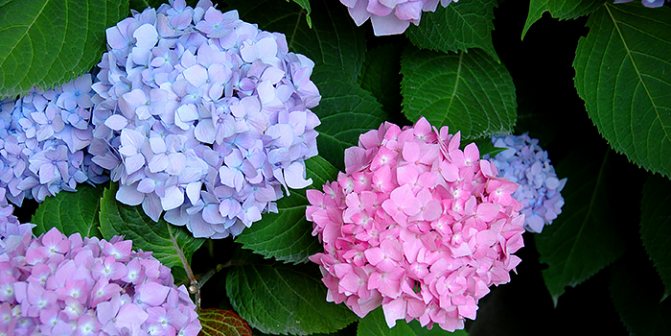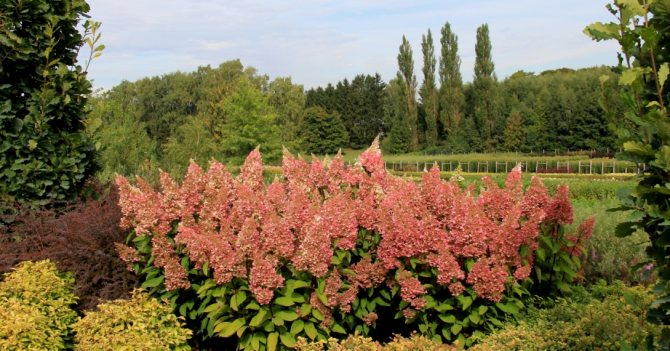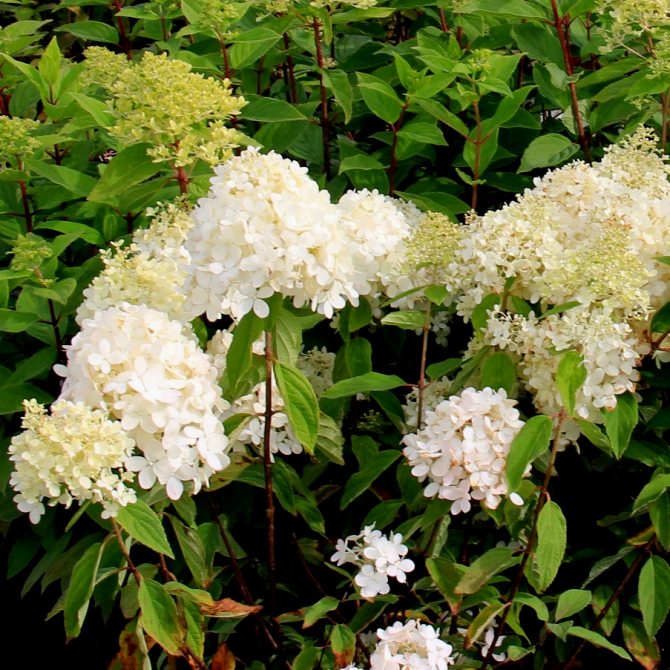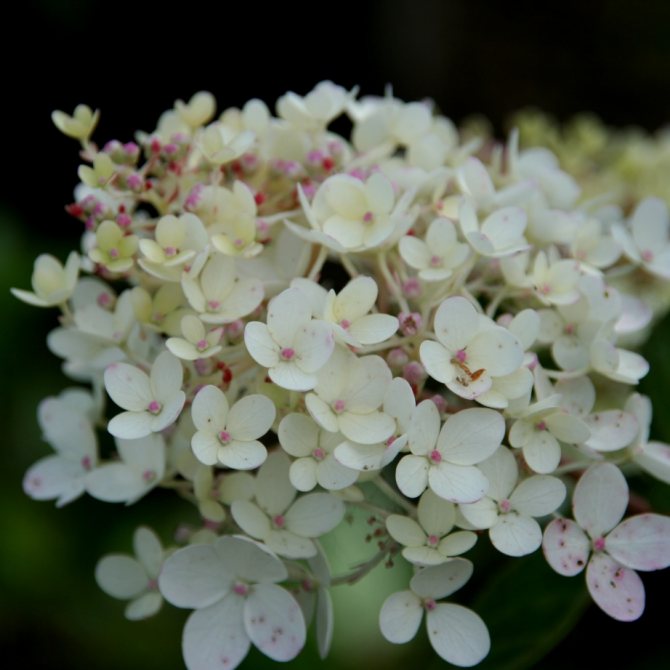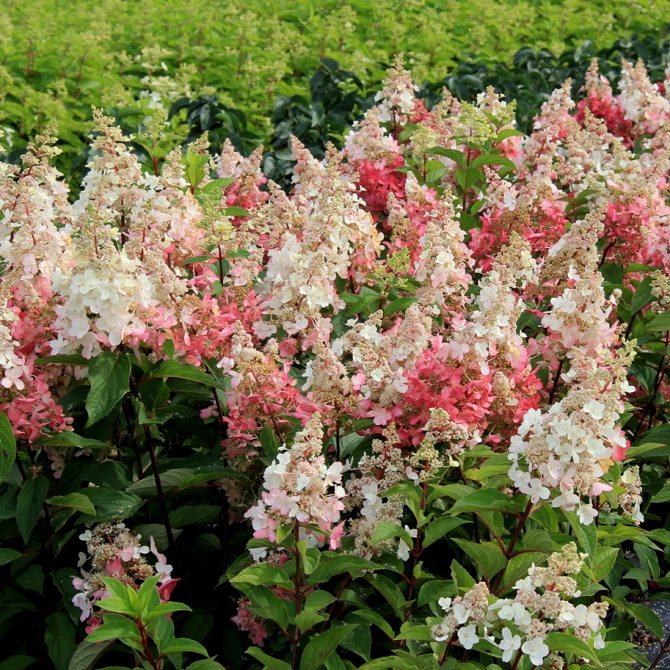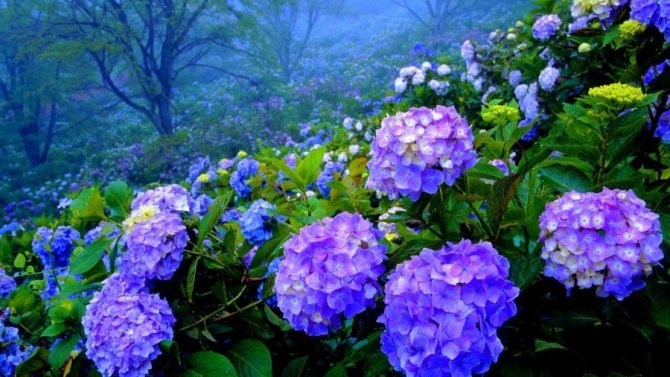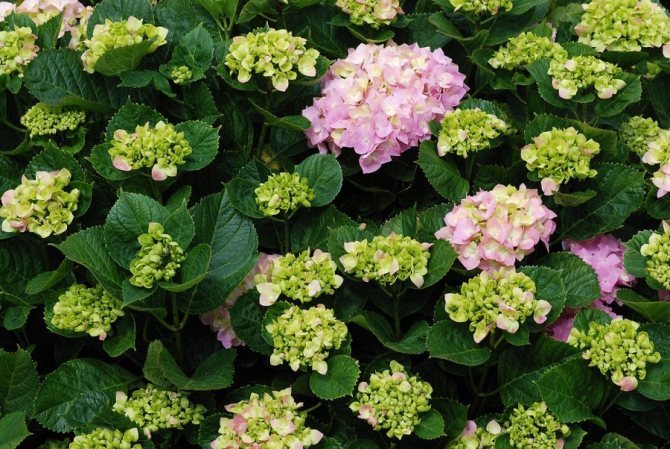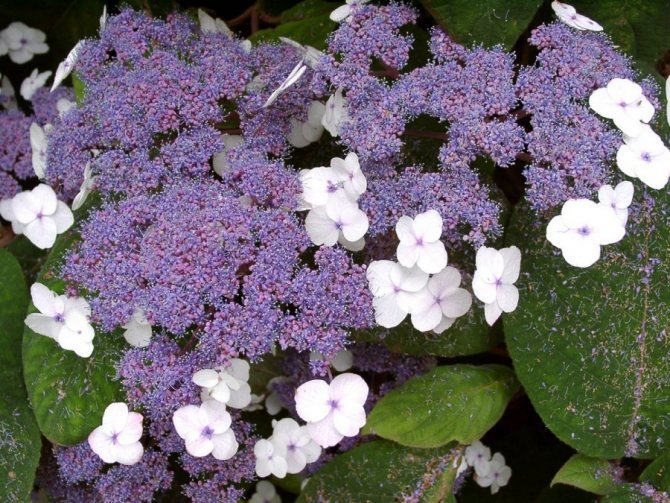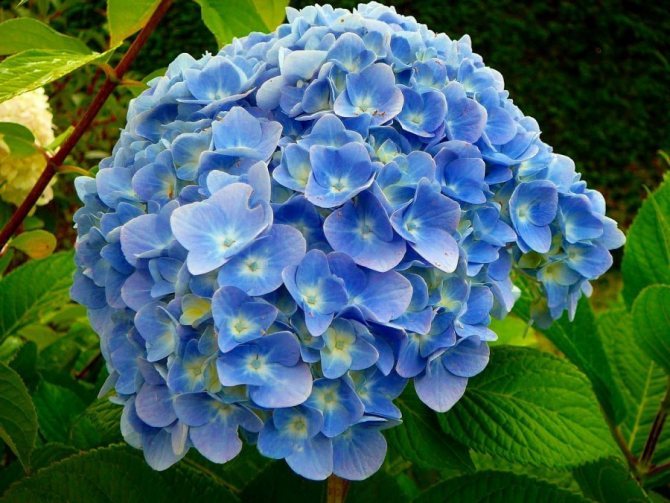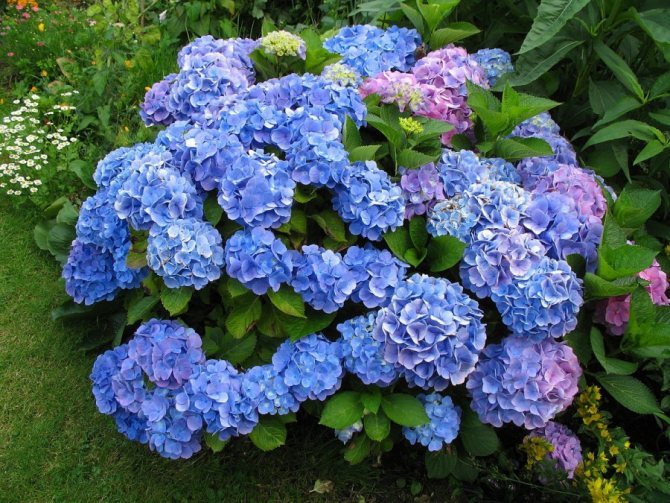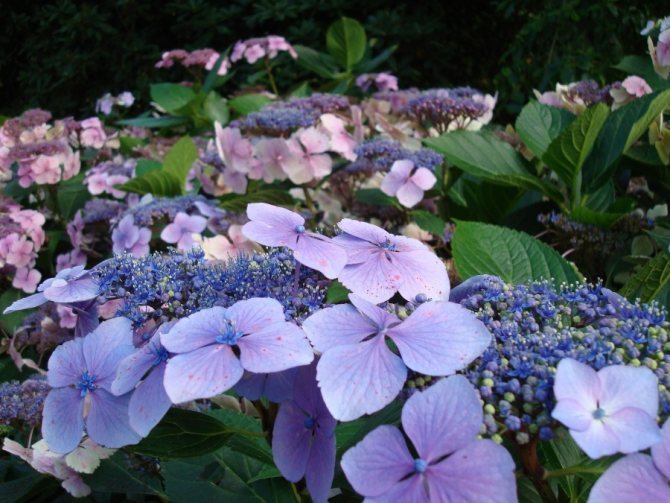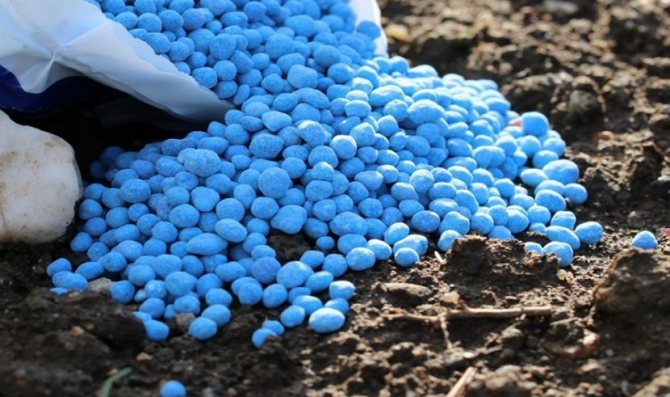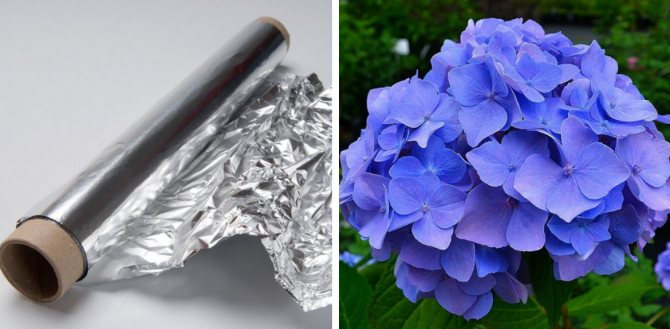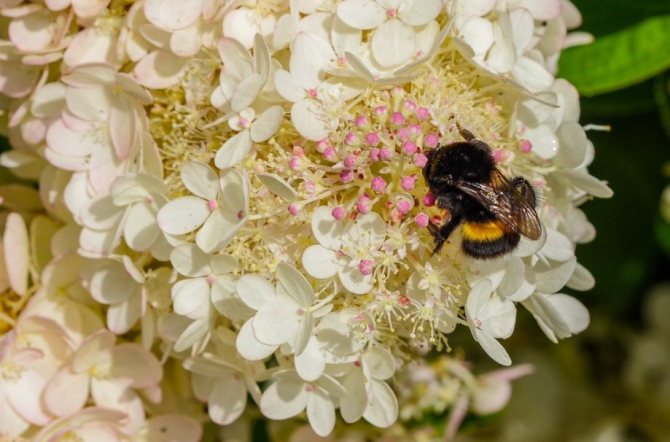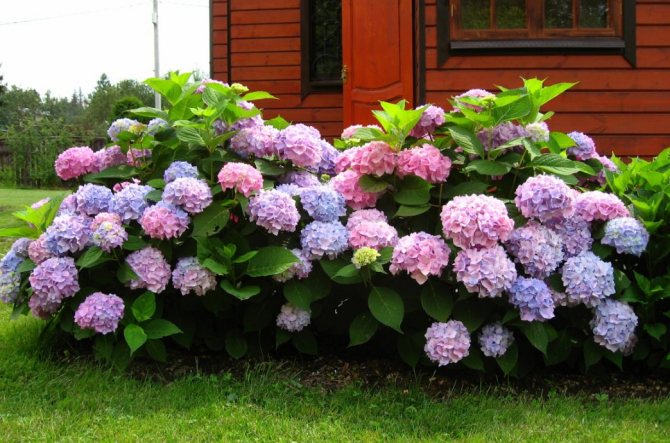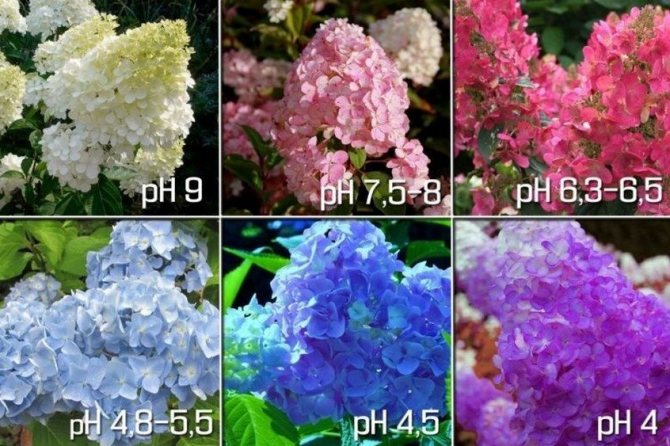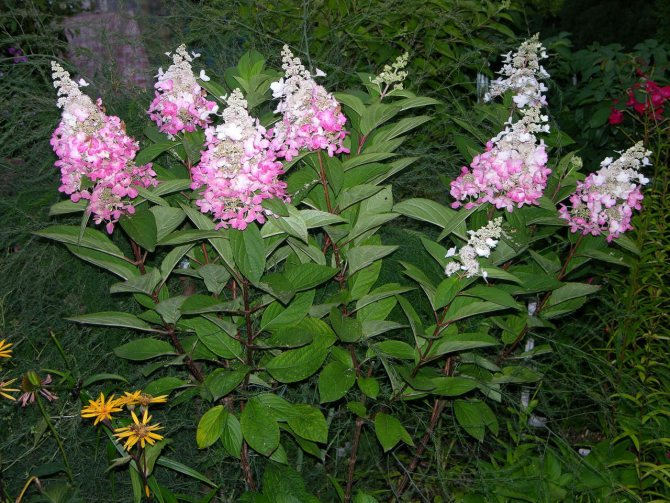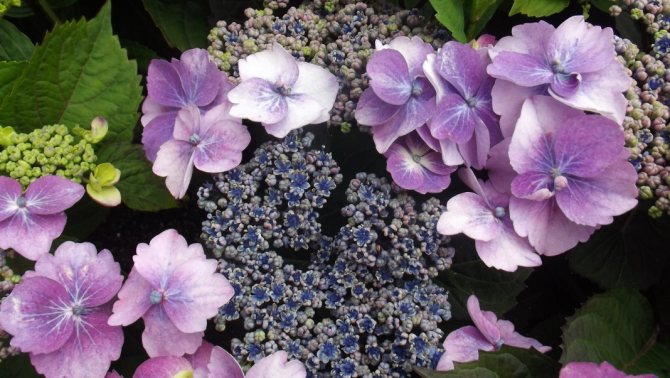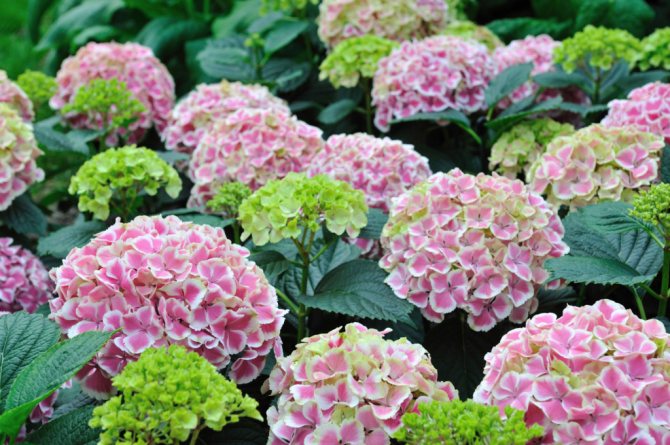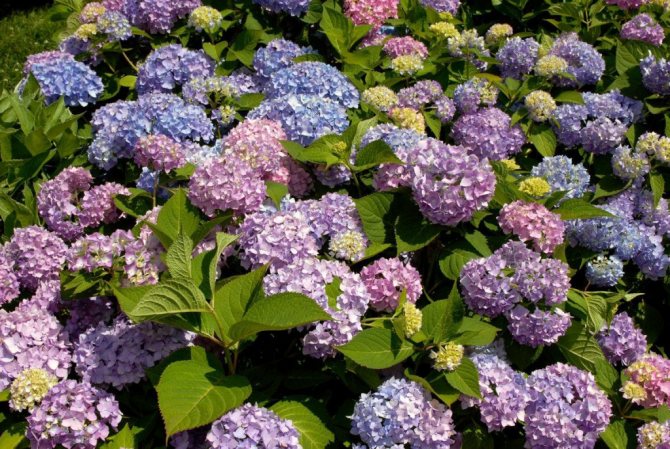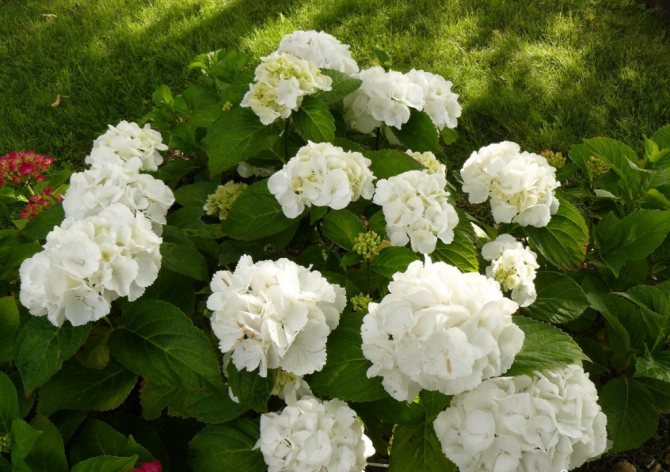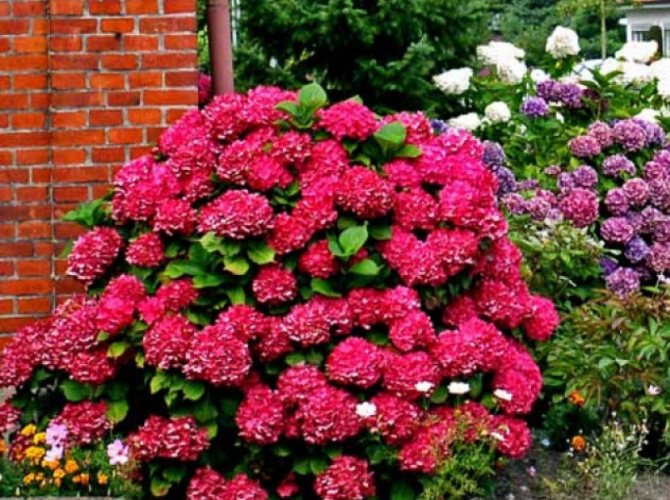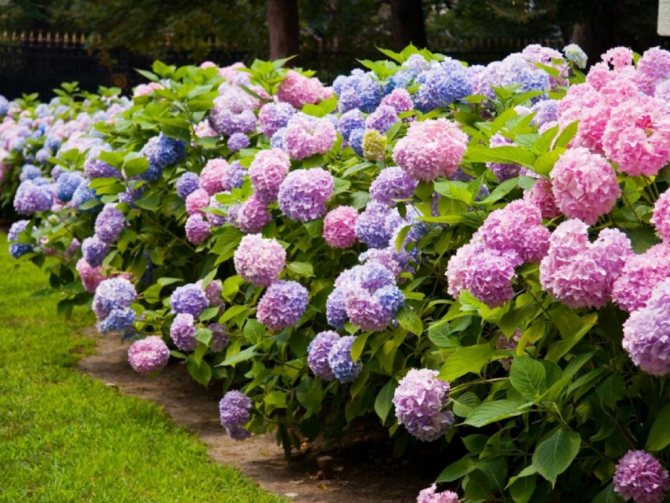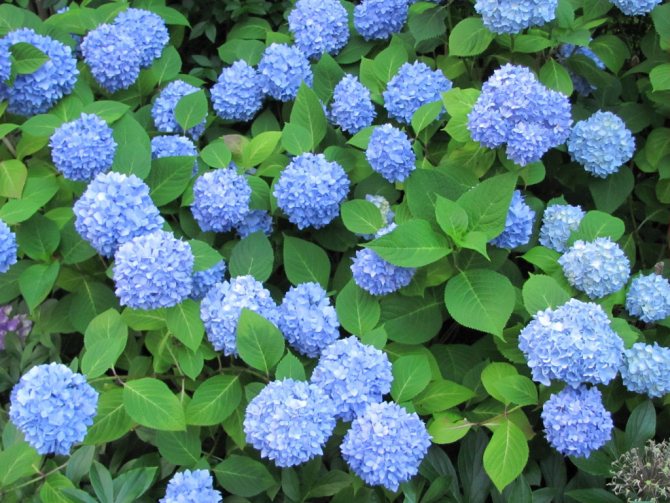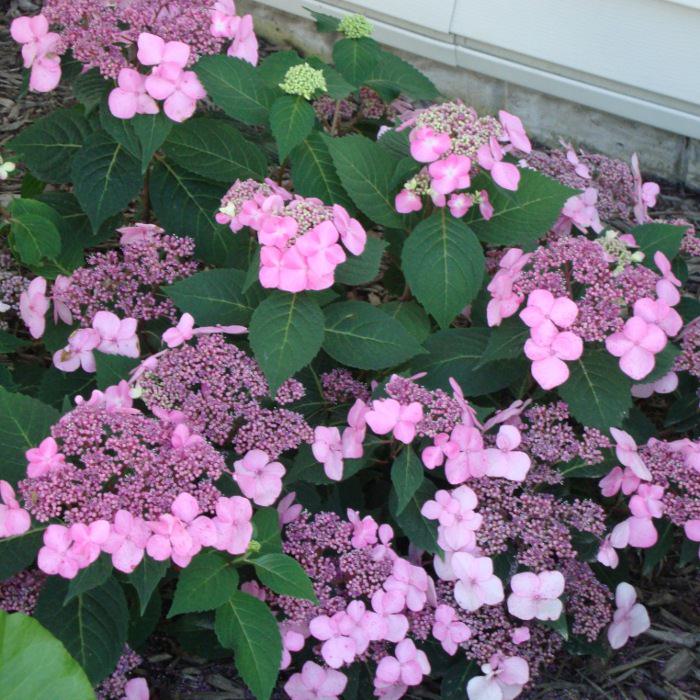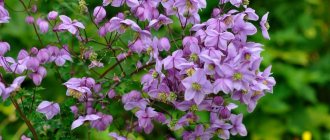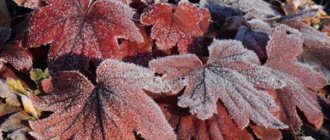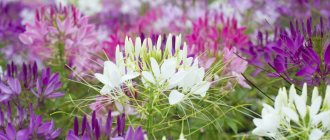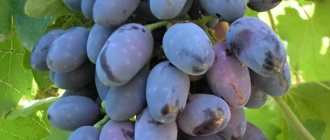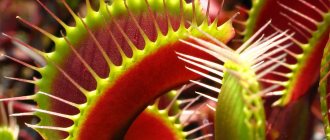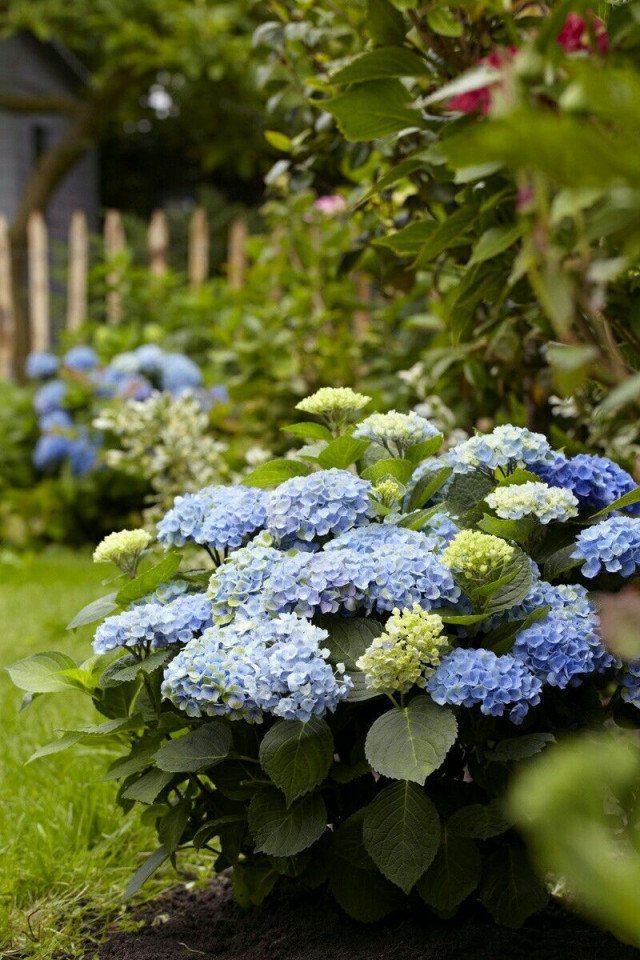
Hydrangea macrophylla
Hydrangea macrophylla Hydrangea is a summer flowering shrub that has rekindled its popularity in popularity over the past decade. Several species are grown all over the world, the most popular are:
- Large-leaved hydrangea
- Hydrangea
- Hydrangea paniculata
- Hydrangea oakleaf
The first part of the publication is devoted to each of the species separately and contains information related to the general questions of gardeners regarding the choice of varieties, the choice of planting and care.
Description of the species
Wild plants can be found in North and South America, as well as in the countries of East Asia. They are large bushes that look like small trees. They have a fairly dense trunk that can withstand medium-sized animals. The flowering period begins in May and ends in November. There are three types of inflorescences: paniculate, thyroid and spherical. Its leaves are small and oval in shape. The tips of the leaf plate are slightly pointed. Most species of this plant shed their leaves for the winter. Some of them are evergreen and adorn gardens with their blossoming appearance throughout the year.
The colors of the inflorescences can be very different. Photos of hydrangea species with names and descriptions confirm this. There are beige, hot pink, purple and deep red shades. Experienced gardeners regulate the colors themselves with fertilizers. For example, if the soil is made alkaline, the petals will turn pink, the neutral soil will give the hydrangea a delicate beige color, and the acidic soil will give it a deep blue.
New varieties of panicle hydrangea 2019
Fresh varieties of ornamental panicle hydrangea appear annually. Breeders are constantly improving the existing varieties and presenting even more colorful and unpretentious plants to amateurs.
Samara Lydia
One of the latest novelties, Samara Lydia, was introduced in 2018, and only hit the Russian market in 2020. The French selection is distinguished by its compact forms, slightly more than 1 m in diameter and in height.


Samara Lydia - the latest novelty with a whitish-purple color
Samara Lydia begins to bloom in July and retains its beauty until autumn. Brings cone-shaped apical inflorescences, at first the flowers are white, and then they become pink and red.
Attention! The variety is suitable for cultivation both in the garden and in closed containers.
Skyfall
The new panicle hydrangea, which hit the world market in 2019, belongs to low shrubs up to 1.2 m in height. In width, the bush grows up to 70 cm, brings very large inflorescences with unusual elongated petals of individual flowers.


Skyfall - a variety with light flowers of an unusual shape
The flowering of the variety begins in July and lasts until September, the shade of flowers is first greenish-white, and then light pink. The variety is ideal for breeding in the middle lane.
Magic Vesuvio
The new variety of 2020 is Magic Vesuvio, with bush sizes up to 1.5 m in height and 1 m in diameter. The shrub bears high and narrow pyramidal panicles of inflorescences, very dense flowering, begins in July.
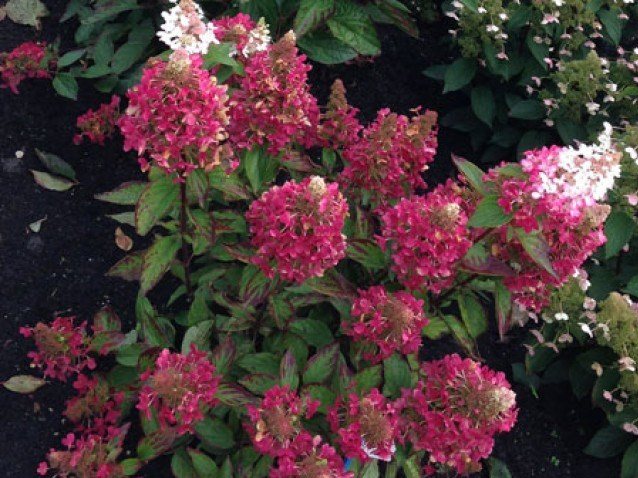

Magical Vesuvio changes its color to crimson red in the fall.
At first, the inflorescences of the Magic Vesuvio have a whitish color, but turn pink very quickly, and by autumn they acquire a crimson-red color.
Care features
The main rules to follow when growing hydrangeas are as follows:
- This flower loves abundant watering and does not tolerate drought. The slightest lack of water threatens the formation of small and inconspicuous buds, as well as yellowing of the foliage.
- This is a sun-loving plant, however, it occasionally needs darkening. He is planted in the garden in such a way that from eleven to two in the afternoon the bushes are in the shade.
- Despite the fact that hydrangea needs fertilization, it does not tolerate organics well. Therefore, when using organic feeding, it should be added in a limited amount, otherwise there will be difficulties in the formation of buds.
- Even the most frost-resistant varieties of hydrangeas are recommended to be insulated for the winter. Spruce branches with a film are usually used. The trunk can also be covered with sawdust and earth on top.
- Hydrangea requires regular pruning. Thus, not only a bush is formed, but also flowering is stimulated.
It is one of the few garden flowers that is highly resistant to insect pests and viral diseases.
Propagation of hydrangeas by seeds
Often, gardeners prefer to plant a hydrangea with seeds, and then transplant it into open ground. For this, a soil mixture is prepared, consisting of peat, park soil and sand. Seeds are sown in a special container and the soil is moistened with a spray bottle. To enhance the effect, the container can be covered with cling film and thus create a greenhouse. The film is opened daily to prevent condensation from forming. After that, the earth continues to be moistened with a spray bottle. After the sprouts with leaves appear, the shelter is completely removed.
As a rule, seeds are sown in the fall, so that after two years, mature seedlings are planted in the garden. The entire period of growth at home, the seedlings are prepared for planting in open ground. To do this, reduce the temperature in winter so that the flowers can grow stronger. In summer, pots with seedlings are taken out into the open air and only in September are they removed back indoors. Young plants do not tolerate drafts, as well as the direct rays of the scorching summer sun.
How to land correctly?
The main advantage of this plant is its simplicity. Even a novice amateur gardener can grow a beautiful bush. The main requirement for this shrub is the correct location.


The plant does not tolerate a very dark place. It is best to choose the most illuminated place. Avoid planting shrubs in direct sunlight. The fact is that they have a detrimental effect on the external state of the plant. On the surface of the leaves, one can observe deep burns or the complete absence of leaf plates.
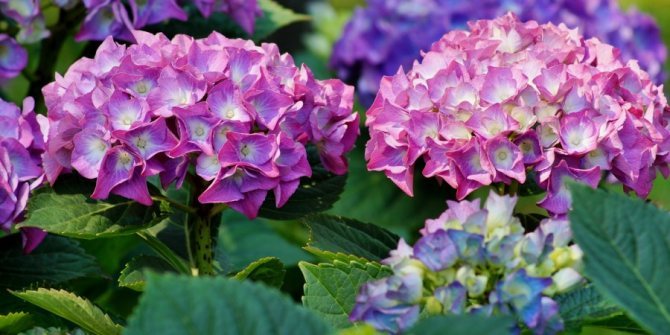

Reproduction is carried out by grafting or dividing an adult bush. For this, lashes are cut, the length of which is about 20 cm. There should be 3 buds on the trunk.
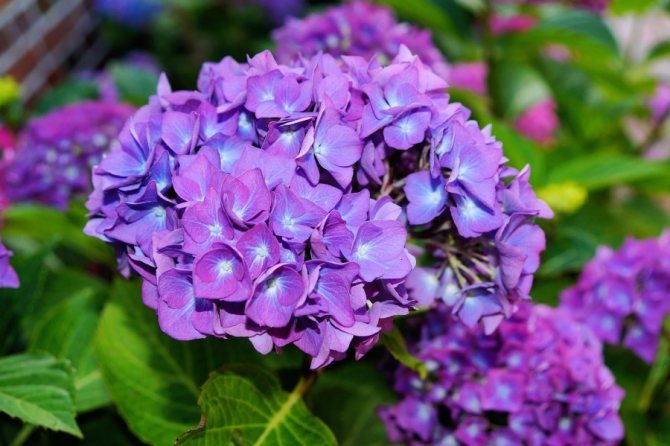

Planting of planting material is carried out in early spring in the first half of April. At this time, the plant is actively preparing for vegetative cell division.
For this, a shallow pit is prepared. The distance between adjacent bushes should be from 1 to 1.5 m. It is recommended to fill the planting pit with a mixture of sand and peat mixed with each other in a ratio of 1: 2.


For fast rooting, you can add urea. It will speed up the regeneration process of the root system. In addition, sulfur compounds and potassium compounds are added to the soil. They have a positive effect on the growth of hydrangeas. The presence of calcareous substances in the composition of the soil has a detrimental effect on the well-being of this shrub.


At the time of planting, it is important to monitor the location of the root collar. It should be 1-2 cm higher from the ground level. After completion, the hole with the bush is watered abundantly with water. In order for the plant to take root quickly, it is recommended to pick off all inflorescences.
Propagation by cuttings
This method is much better than the previous one, as it allows you to plant plants in one year. Shoots of young plants are used for cuttings. It is very important to keep them moist, otherwise they will be very difficult and difficult to germinate. Therefore, immediately after cutting, the cuttings are immersed in water. At the appendix, the top with the bud is cut off, and the remaining part is divided into about three parts with such conditions that each has at least four or six leaves. It is recommended to use growth stimulants when sprouting roots. As soon as the roots appear, the shoots are transplanted into soil consisting of peat and sand. Water them twice a week. Cuttings are planted in September and covered for the winter so that they do not freeze out. Already in a permanent place, young hydrangeas are planted, as a rule, in the spring.
Layering or division
In the lower part of the bush, tubules are dug into which basal shoots are laid. Then they are watered and made of wire. In places of constriction, as a rule, roots are formed. As soon as the young plants sprout, they are dug up and transplanted to a permanent place.
In early spring, you can dig up a large root and then divide it into several parts. The roots are trimmed a little for better rooting. It should be borne in mind that this method is not suitable for panicle hydrangea.
Planting and leaving
After two years, the bushes begin to be planted in the garden. To do this, it prepares the soil as follows. Chooses a place and digs up the soil. Depending on the characteristics of the soil, it can be acidified with the help of special preparations or made more alkaline. A hole is dug, which is twice the volume of the root. A small amount of organic matter is laid out at the bottom of the pit, the roots of the bush are leveled and planted in the pit. Plants occasionally loosen. The bushes are watered every three days. For an adult plant, you will need up to fifty liters of water.
Pruning is done the first time the plant is three years old. As a rule, the stems that grow inside the bush are removed. And also in the fall, cut off inflorescences that have already faded.
Large-leaved variety


Its height reaches two meters. It differs from other types of hydrangea by erect shoots. The inflorescence is usually spherical, reaching twenty-five centimeters in diameter, or thyroid, the diameter of which is fifteen centimeters. What flowers are large-leaved hydrangea? It blooms usually in the middle of summer, forming beautiful pink, bright crimson, white and deep blue flowers. The disadvantage of this species is that it is practically not winter hardy. Therefore, it has to be covered for the winter in order to preserve the kidneys.
This is quite troublesome to do. In addition, such a procedure does not always lead to the desired result. Sometimes the bushes still freeze in winter and remain without inflorescences for a whole year. The most cold-resistant are the following varieties of hydrangea species:
- Red sensation, reaching a height of eighty centimeters. Typically, you can see it bloom twice. The first time in May and the second in October. The inflorescences of this variety have a rich scarlet color.
- Expression also barely reaches a height of one meter. It has gorgeous pink double petals.
- The size of the Ever peppermint bushes is slightly inferior to the previous two varieties. Its inflorescences are painted in two shades at once: white with pink or blue with pink.
- And also a magnificent variety "endless summer" with inflorescences in the form of a ball is distinguished. The petals are colored ruby or blue.
- Early blue has blue flowers and a fairly strong root system.In southern countries, this variety can grow up to two meters in height. However, in cool climates, it is barely one meter tall. He needs shelter for the winter. Sometimes gardeners transplant it into a tub and bring it indoors. Thanks to its strong roots, it perfectly tolerates an annual transplant.
- Romance blooms with rich pink buds, which do not open simultaneously, but gradually, starting from the center.
- Ramars mars has very large inflorescences, the diameter of which sometimes reaches twenty centimeters. He is able to change shades throughout his life. In order to achieve a pink color, the plant is fed with aluminum sulfate.
The varieties described above were bred not so long ago for countries with cool climates. The peculiarities of large-leaved hydrangea also include moisture-loving and love of feeding. In mineral-poor soil, these varieties tend to grow poorly. In addition, it is advisable to cover them during the summer sun.
The most beautiful and unpretentious varieties of panicle hydrangea
In search of a beautiful hydrangea for the garden, summer residents pay special attention to unpretentious varieties. It is easy to achieve lush flowering from such plants, since it depends little on the weather and the quality of the soil.
Mega Pearl
Panicle hydrangea Mega Pearl is a large shrub up to 2.5 m tall. Brings fragrant cone-shaped inflorescences, large and wide. At the beginning of flowering in July, the hydrangea is greenish-white, then it becomes creamy, and by autumn it acquires a pinkish-red hue and fades by October.
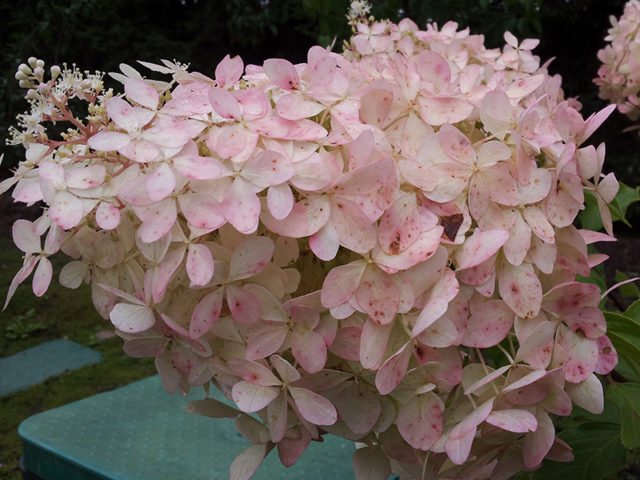

Mega Pearl has a pink-red bloom
Prefers loose and moderately moist soils, but can bloom well on poor soil. Mega Pearl develops both in illuminated places and in a small shade, tolerates frosts below -30 ° C and rarely suffers from diseases. It is possible to grow the variety throughout the territory of Russia without much effort.
Goliath
Among the best varieties of panicle hydrangea is Goliath. A powerful shrub extends up to 3 m in height. Flowering of Goliath begins at the end of July and lasts until the last days of September, the inflorescences look like narrow cones, white at the beginning of flowering and pale pink towards the end.
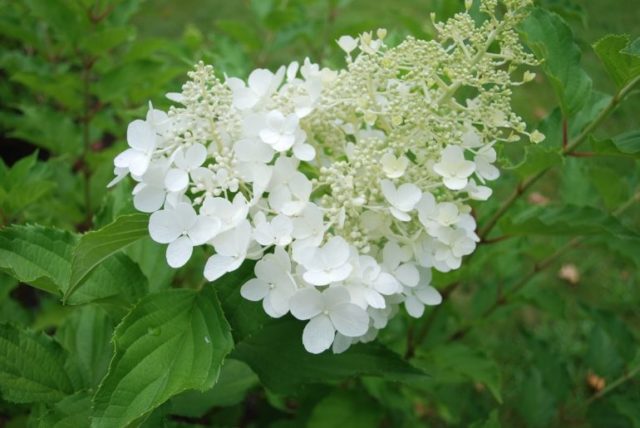

Goliath is a white variety that changes color to pink
The variety tolerates open sun and shade well, does not require winter shelter. Goliath is best planted in fertile, acidic soil, however any other soil is suitable.
Bombshell
Bombshell is a small shrub up to 80 cm in height and up to 1.5 m in diameter. The bush is round in shape, densely leafy. It blooms from mid-June and remains decorative until frost, and pyramidal inflorescences up to 16 cm in length have a cream or white-greenish color. In the last stages of flowering, the hydrangea may turn pink.
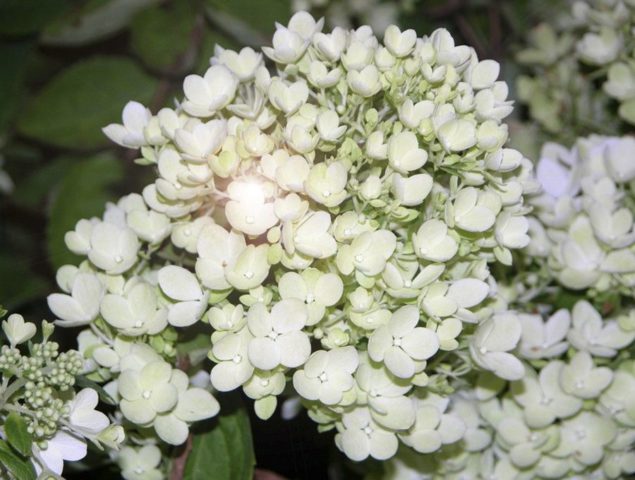

Bombshell - low-growing, undemanding shrub
Bombshell grows well on all types of soil and has increased frost resistance. The bush is rarely affected by pests and diseases, and the hydrangea also holds its shape for a long time, so it rarely needs a haircut.
Hydrangea paniculata
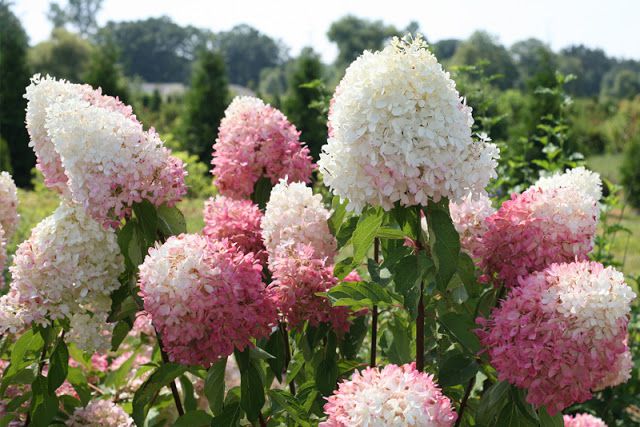

It blooms for a long time, throughout the summer. This is a rather tall type of hydrangea, sometimes reaching three and a half meters. The inflorescences consist of fruitful and sterile flowers. The leaves of the panicle hydrangea are ovoid, with a pointed end. As a rule, they are lowered down. What colors are panicle hydrangea? Very often during flowering, the shades change from brightly saturated to pale:
- In southern countries, the floribunda variety is very common, which begins to bloom in mid-autumn. He has very interesting light green inflorescences, lowered down.
- Another variety, in which the inflorescences have a pale green tint, is called "limelight". The flowers are arranged quite tightly to each other. The height of the bush reaches one hundred centimeters.
- Quite a popular variety "Phantom" has gorgeous cone-shaped inflorescences, consisting of white, fluffy flowers, which begin to turn pink by the end of flowering. The height of the tree reaches two meters.
- Beloved by many gardeners, "pinky-winky" has cone-shaped inflorescences, consisting of white and pale pink flowers. Its height also very often reaches two meters.
- "Grandiflora" has round white inflorescences, like all varieties of panicle hydrangea.
- Perhaps one of the most spectacular varieties is “vanilla freise”. She has extremely showy large inflorescences that completely cover the bush. The color of the buds is so interesting that it is difficult to convey in words. Large flowering milk mushrooms resemble a strawberry-vanilla dessert.


The undersized varieties include "Daruma" and "Early Sense". "Daruma" has reddish foliage and slightly flattened flowers. "Earley Sense" has a rich pink shade with white splashes. Her leaves are dense and dark green.
How beautiful these flowering shrubs look in the photo! Types and varieties of hydrangeas are of interest to many gardeners.
Hydrangeas with very large inflorescences
One of the most popular groups of hydrangeas. Large paniculate inflorescences are one of the brightest accents in the autumn garden.
Hydrangea paniculata grade Magical Moonlight (Kolmagimo)
The bush of hydrangea paniculate up to 2 m high with very large (up to 40 cm) dense inflorescences, greenish at the beginning of flowering, after white. The variety is distinguished by lush and long flowering.
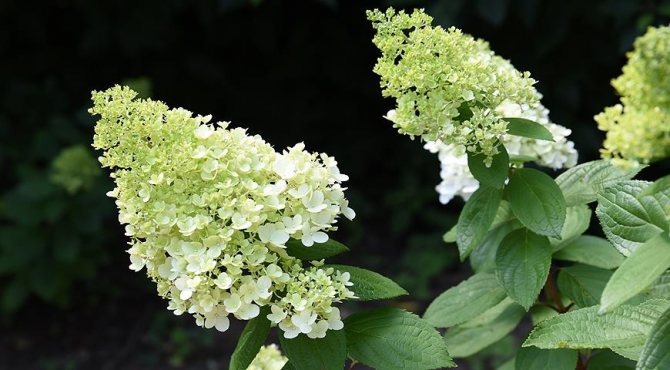

Hydrangea paniculata Magical Moonlight (Kolmagimo)
Hydrangea panicle grade Polar Bear
The bush is 1.5–2 m high. The inflorescence is dense and very large (40 cm and more). The flowers are snow-white, by autumn they turn slightly pink.
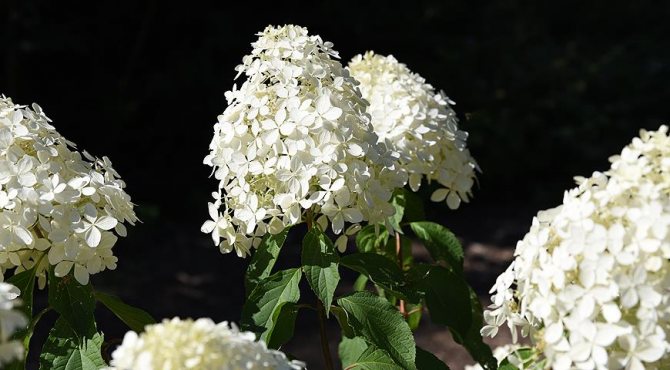

Hydrangea paniculata Polar Bear
Hydrangea paniculata Phantom variety
The bush is up to 2.5 m high with large (30–40 cm, under favorable conditions up to 50–60 cm) inflorescences, white at the beginning of flowering, lilac-pinkish at the end.


Hydrangea paniculata Phanton
Large inflorescences in hydrangeas are obtained only with regular pruning.
Tree hydrangea varieties
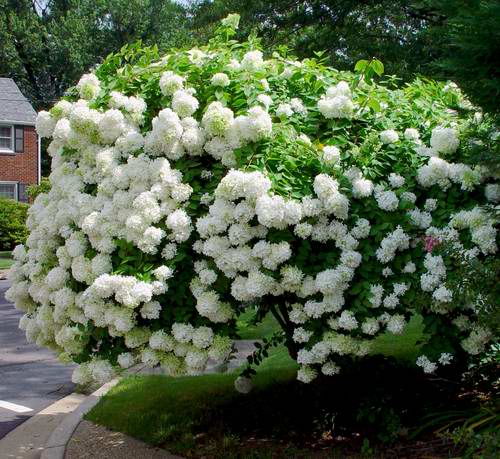

Bushes very often grow up to three meters high. They have a number of advantages. First of all, they are extremely winter hardy. Even after harsh winters, the bushes thrive and bloom throughout the summer. They try to propagate these types of garden hydrangeas using cuttings, which is quite convenient compared to seeds. On the surface of the shoots, you can notice a light fluff, which gives this plant a sophistication. The inflorescences are usually large and conical in shape. Shrubs of tree hydrangea delight their owner not only throughout the summer, but also until mid-autumn. The best soil for it is slightly acidic soil. Here are the tree hydrangeas:
- Quite original and pretty "Invincibelle" has a pink tint. This variety blooms, as a rule, twice a year. In order to stimulate flowering, it is enough to cut it off. Within a month and a half, new shoots can be noticed.
- "Grandiflora" is distinguished by its high growth, which sometimes reaches three meters. The inflorescences are painted in a pale green hue, which eventually turns into a deep white.
- The extremely popular "annabelle" has inflorescences that are sometimes 25 centimeters in diameter. Gardeners love to grow this variety because of its fast growth and unpretentiousness.
The section presents a photo of a tree hydrangea. Photos of plant varieties are of interest to many novice gardeners. As a rule, all varieties begin to be planted in early spring and only rarely in autumn. Before planting, you should carefully check and cut the roots, soak them for a day in a growth accelerator, and after planting, pour plenty of water.Organic fertilizers, park soil, sand and humus are added to the pit where the plant will be planted. An adult bush is watered with twenty liters of water and at least twice a week. It should be fed and pruned regularly. It should be borne in mind that the first time feeding is carried out in early spring, and the second - during the formation of buds.
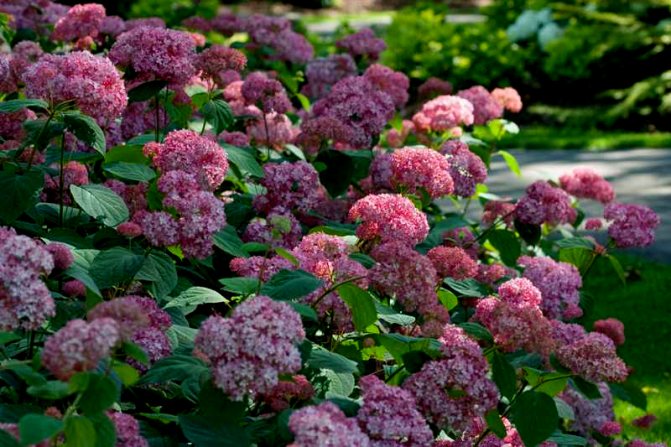

Photos and names of garden hydrangea species are presented in the article. You can learn about caring for this plant from the reviews of experienced gardeners. They argue that hydrangea loves loose soil very much, and pruning is one of the most important elements of care. It can be sanitary (when broken and dried inflorescences are removed), restoring (pruning is carried out in a radical way, that is, leaving short branches) and forming, during which a spectacular crown is created for the shrub.
Be sure to feed the plants with nitrogenous and potassium fertilizers after the procedure. Pruning is highly discouraged for a plant under three to four years of age.
Despite the excellent winter hardiness, nevertheless, it is recommended to cover the tree hydrangea for the winter. This applies primarily to those regions where winter frosts begin early, when the plants are not yet ready for them. Coniferous branches are usually used for this purpose. The disadvantages of the tree hydrangea, the photos and names of the varieties of which are presented above, is the tendency to fungal diseases, which can be eliminated with the help of the preparations "Vitaros" and "Fundazol".
The best varieties of oak-leaved hydrangeas
Oak-leaved hydrangea varieties are an elegant plant that is resistant to negative weather conditions. It is patient with temperature changes, but it is not advised to overcool it. Large leaves resemble oak in shape.
Snowflake
Rating: 4.9
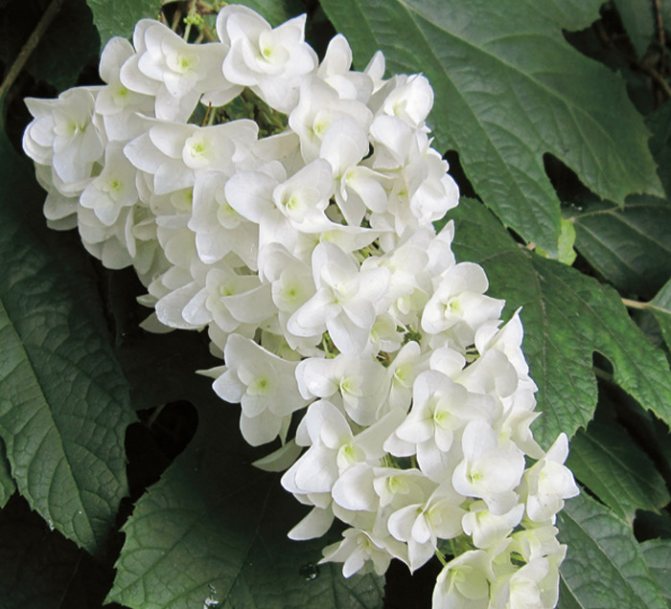

Luxurious snowflakes brushes will provide a real winter garden at their summer cottage. Thick bushes in the form of snow-white balls delight those around from spring to late summer. By the end of flowering, the petals acquire a reddish-green color. An unusual appearance is provided by oak-shaped leaves. In autumn they turn maroon. The snowflake is not as demanding on regular watering as other species. The growth rate of hydrangea is average. It prefers acidic soils and tolerates changing weather conditions well. Young plants are advised to be covered before winter.
Dignity
- good drought tolerance;
- original appearance;
- long flowering.
disadvantages
- finicky to the composition of the soil.
The Snow Queen
Rating: 4.8
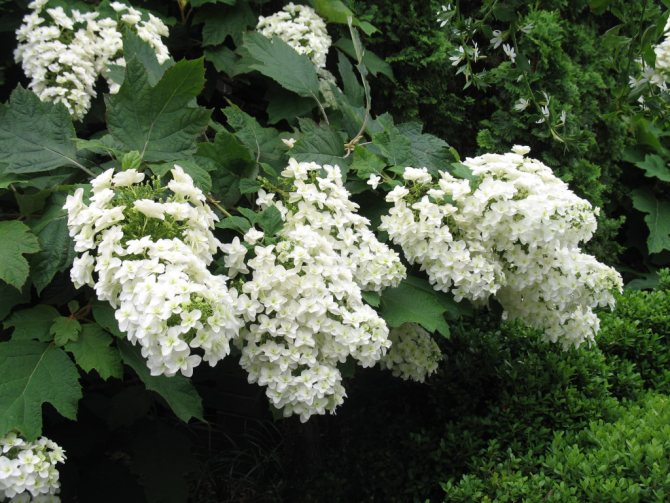

The oak-leaved variety Snow Queen is a unique shrub native to Southeast America. The crown diameter reaches 1.8 meters. The growth rate is moderate. Conical inflorescences are composed of snow-white petals. Compared to paniculate varieties, the Snow Queen is not so winter-hardy. Therefore, it is recommended to cover the bushes, bending down the shoots. But this variety grows well even on dry or too wet soil. It is important to provide drainage during planting so that the root collar does not become infected with fungus. If you know how to properly care for the Snow Queen, you can enjoy the snow-white flowers in June and July, and at the end of the season, admire the petals of a deep burgundy hue.
Dignity
- good endurance of adult bushes;
- beautiful appearance.
Dubolistnaya
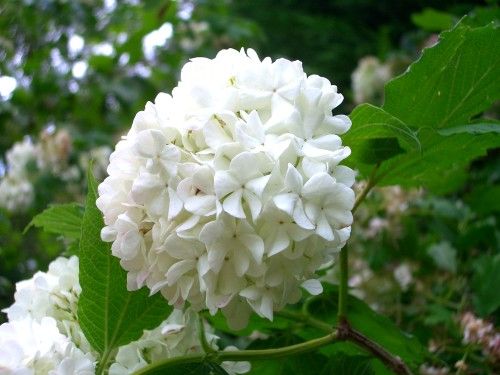

The leaves of this type of hydrangea are very similar in appearance to oak with a very spectacular reddish color. Inflorescences are most often white. These are rather low shrubs, barely reaching one meter in height. What are hydrangeas? The most popular large-leaved varieties are as follows:
- The "amethyst" variety grows up to one and a half meters in height. The inflorescences are colored in a delicate coral shade. Their appearance resembles spears.
- "Princess" is the most abundant of all oak-leaved hydrangeas. The petals are white.
- Quite a high grade "snow-white domes", the bushes sometimes reach one and a half to two meters.The buds, collected in rather large inflorescences, are also white. The photo of the "snow-white dome" is shown above.
- Variety "harmony" because of the abundant flowering very often has to be tied up. Its leaves turn purple in autumn. It looks pretty impressive.
- The leaves of the "burgundy" are colored in the same way. The edges of the leaf blade are rounded, and their size is slightly longer than that of other varieties of oaky hydrangea.
- Perhaps the most attractive variety is the "little honey cake". It got its name from the yellow leaves, which acquire a burgundy hue in the fall.
Caring for oaky hydrangea is practically no different from other plant species. She loves moisture and sun, good feeding and loosening of the soil. In winter, the temperature should not drop below 23 degrees. Otherwise, the hydrangea will have to be covered so that it does not freeze.
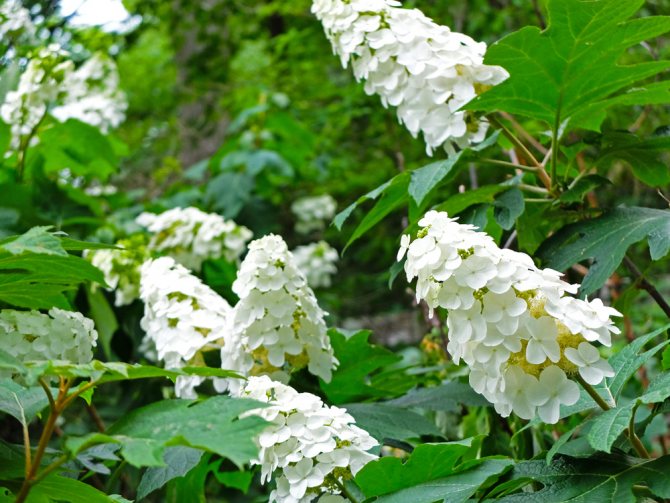

These types of hydrangeas are only pruned in the spring. Moreover, as a rule, they are limited only to the removal of dried inflorescences. It practically does not need regular pruning, unlike other plant species. Of the disadvantages of tree hydrangea, its crane is noted for its low winter hardiness and a tendency to fungal diseases. These plants are propagated by cuttings or layering.
Rating of the best varieties of hydrangeas
| Nomination | a place | hydrangea variety | Rating |
| The best varieties of panicle hydrangeas | 1 | Grandiflora | 4.9 |
| 2 | Polar Beer | 4.8 | |
| 3 | Phantom | 4.7 | |
| 4 | Limelight | 4.6 | |
| The best varieties of tree hydrangeas | 1 | Annabelle | 4.9 |
| 2 | Diamant Rouge | 4.8 | |
| 3 | Grandiflora | 4.7 | |
| 4 | Sterilis | 4.6 | |
| 5 | Pink Bella Anna | 4.5 | |
| 6 | White House | 4.4 | |
| The best varieties of large-leaved hydrangeas | 1 | Nico blue | 4.9 |
| 2 | Endless Summe | 4.8 | |
| 3 | Alpengluchen | 4.7 | |
| 4 | Shniebol | 4.6 | |
| 5 | Peppermint | 4.5 | |
| The best varieties of oak-leaved hydrangeas | 1 | Snowflake | 4.9 |
| 2 | The Snow Queen | 4.8 |
Petiolate hydrangea


It does not have a stable trunk and therefore spreads along the ground. It is very often compared to vines. The beauty of this species can be seen in the photo above. A description of the varieties of petiolate hydrangea is given below. Its advantage lies, first of all, in the fact that with the help of this plant you can decorate the wall of the house and create any compositions. It easily takes the form that the garden designer suggests to it. The most popular varieties are as follows:
- Curly hydrangea has pretty white umbrella-shaped inflorescences.
- The hydrangea "petiolaris" has a high growth. It grows extremely quickly and literally envelops the building and tall trees in lush white inflorescences. People with an artistic taste are able to create magnificent garden solutions from petiolaris.
- Also often used in garden design "cordifolia". Like both previous varieties, "cordifolia" blooms with white flowers.
When growing this type of hydrangea, special attention should be paid to feeding the plant. The fact is that these flowers are very sensitive to good soil, but practically cannot feed on their own.
The article contains varieties of hydrangea with photos and names.
Garden hydrangea, or large-leaved
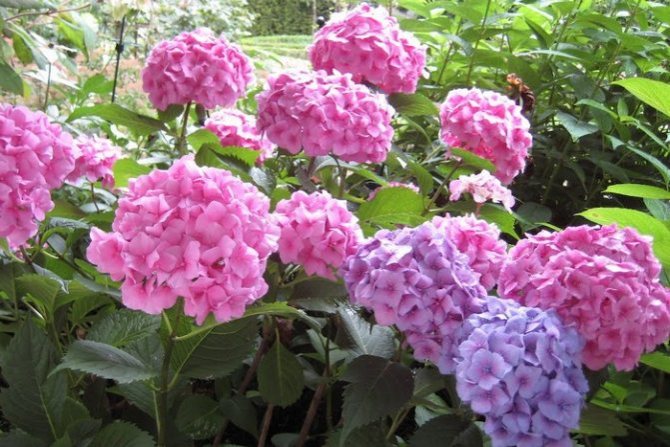

The most famous type of hydrangea, popular during the Easter period. In addition to growing in the garden, they decorate the interior of houses, grow in pots. Many interesting hybrid varieties with a wide variety of colors and shapes. They bloom in blue or pink and shades, changing shades as they bloom, depending on the variety and pH of the soil. Predominantly umbellate inflorescences, single or complete.
Due to the shape of the inflorescences large-leaved hydrangea, is divided into two groups:
- dome-shaped inflorescences (‘Ayesha’, ‘Blue Bonnet’, ‘Altona’)
- flat inflorescences (‘Blue Wave’, ‘Lanarth White’, ‘Tricolor’)
New to the species are the 'Endless Summer Collection' blooming on this year's shoots and last year's shoots, and the 'All Summer Beauty' blooming on this year's shoots. Both groups bloom longer, repeating flowering repeatedly during the summer.
Popular varieties: Rose Bouquet, So Long Sunny, Ever Pink, Renata Steiniger, Magic Amethyst, Schloss Wackerbart, Blue Bodensee, Peppermint, Tugese, Endless summer, Nikko Blue, Forever Ever, Romance, Leichfeier, Nikko Blue, Hot Red, Camilla , Hamburg, Nikko Blue, Schloss Wackerbarth, Miss Saori, Blue Bird, Masya, Blaumise, Bouquet Rose.


